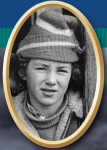-24: What’s in a name?
When I visit schools, students often bring me little slips of paper with their names written on them, and ask me to include them in my next book. But names are too powerful to be casual. It may be that no one but me cares about the inside story of my names, but I need to know.
 Take Nell, for instance, the star of Graveyard of the Sea. Nell is the character most like me, or rather, most like I imagine myself. I wanted her name to have something of me in it. Since my real name is Penelope, there’s lots of scope. One of the short forms is Nell, which is also a short form for Eleanor. Eleanor means “light”, or “ray of sunshine”, and Penelope means “the woman who waits”, after Odysseus’ long-suffering wife. Nell lives in a lighthouse, so both meanings fit. And if the name fits, it’s so much easier to get the character to fit.
Take Nell, for instance, the star of Graveyard of the Sea. Nell is the character most like me, or rather, most like I imagine myself. I wanted her name to have something of me in it. Since my real name is Penelope, there’s lots of scope. One of the short forms is Nell, which is also a short form for Eleanor. Eleanor means “light”, or “ray of sunshine”, and Penelope means “the woman who waits”, after Odysseus’ long-suffering wife. Nell lives in a lighthouse, so both meanings fit. And if the name fits, it’s so much easier to get the character to fit.
 Murphy, from A Terrible Roar of Water, means sea-warrior. In that he has to battle a tsunami, I wanted the strength of such a name.
Murphy, from A Terrible Roar of Water, means sea-warrior. In that he has to battle a tsunami, I wanted the strength of such a name.
Sometimes I borrow names from real people, but not in a random way. In Day of the Cyclone, I was trying to create a community of people who could work together, so I drew every single name in the book from a dear family of my acquaintance, one whose many members share close ties. One must tread carefully here, as not everyone wants to be commemorated in this way. I’ve heard one person say the very idea makes them feel uncomfortable.
For my main character in Red River Raging, I reflect back to my pondering about Tom Sawyer and Huck Finn on the banks of the Mississippi. Finn is kind of a cool name for a boy who lives on the banks of a river. It’s Scottish in origin, short for Finlay, and means “fair warrior”. The Scots settled the Red River Valley; they were the ones who stayed after the devastating flood of 1826. It fits.
This book will be about different kinds of strength, so I pick Armstrong as a last name. Also Scottish, it means, unsurprisingly, “strong arm.” I’ll have his great-grandfather known by this name to emphasize the point.
I like Louis de Meuron for the mysterious stranger because it comes from the history of the valley (more on that later). But the mysterious stranger and great-grandfather are going to be friends, and my editor has just pointed out that putting “Louis” and “Armstrong” together will send many minds rushing off in another direction. There is no jazz in this book. I settle for Peter instead, after Peter Rindisbacher, an artist who settled on the Red River in 1821, and whose work has become important for researchers studying early settlements. He died from poisoning, either by the hand of his jealous wife or by licking his paintbrush too often; no one really knows. Much as I’d like to put him in the book, he doesn’t fit. If I use his name, I won’t forget him.
Overdone? Perhaps. But it’s like a little secret I share with myself, part of what makes the story mine.





